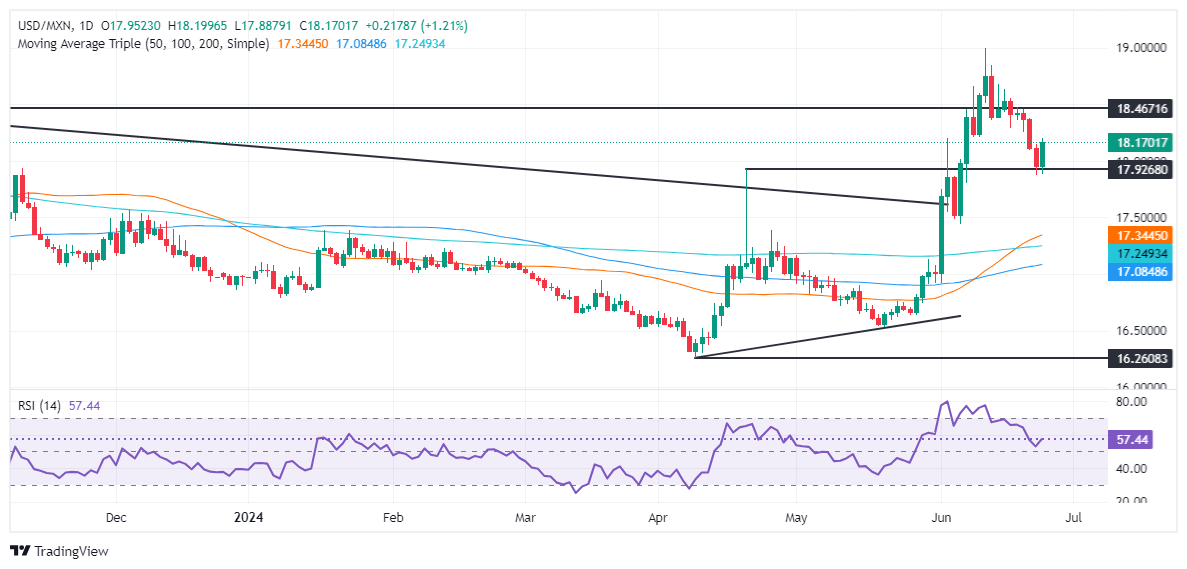Mexican Peso dives as Fed’s aggressive tone spook buyers

- Mexican Peso depreciates sharply with USD/MXN trading back above 18.00, gaining over 1%.
- Fed Governor Michelle Bowman’s comments on holding policy rates steady and willingness to raise rates pressure the Peso.
- Upcoming Banxico monetary policy decision on Thursday, with most economists expecting rates to remain unchanged at 11.00%.
The Mexican Peso depreciated sharply against the US dollar as Federal Reserve (Fed) Governor Michelle Bowman was hawkish compared to San Francisco Fed President Mary Daly, who was concerned about the labor market, stressing that the dual mandate risks are balanced. Nevertheless, the USD/MXN trades at 18.15, gaining more than 1%.
The Peso was stressed after Bowman emphasized that the policy rate would be held steady “for some time,” adding that there has been “modest further progress on US inflation” and that she’s willing to raise rates if inflation stalls.
San Francisco Fed President Mary Daly stressed that the Fed must “exhibit care” as it aims to finish the job of bringing down inflation, adding that it “is not the only risk we face.”
Mexico’s economic docket featured June’s mid-month inflation data on Monday, ahead of the Bank of Mexico (Banxico) monetary policy decision on Thursday. The Citibanamex survey showed that most economists expect rates to be unchanged at 11.00%, yet they expect the central bank to cut rates until August.
Daily digest market movers: Mexican Peso tumbles despite high inflation warranting Banxico’s rate holding
- Mexico’s June mid-month consumer prices rose above estimates, which would likely deter Banxico from easing policy, on June 27.
- Headline inflation jumped from 4.70% expected to 4.78% YoY, though core prices edged lower from 4.31% to 4.17% YoY.
- Citibanamex survey showed economists priced out fewer rate cuts by the central bank, estimating rates will be lowered to 10.25% in 2024, up from 10.00%. Regarding the USD/MXN, the consensus estimates the exchange rate will end the year at 18.70, up from 18.00 in the previous report.
- Regarding economic growth, the consensus revised the Gross Domestic Product (GDP) for 2024 downward from 2.2% to 2.1% YoY.
- Last week’s Banxico’s verbal intervention underpinned the Mexican Peso as the USD/MXN hit an 11-day low. However, the Fed’s hawkish comments weighed on the emerging market currency.
- CME FedWatch Tool shows odds for a 25-basis-point Fed rate cut at 59.5%, down from 61.1% last Monday.
Technical analysis: Mexican Peso falls as USD/MXN rallies back above 18.00
The USD/MXN uptrend remains intact after yesterday’s pullback beneath 17.90, which sounded the alarms that sellers were back in control. Nevertheless, momentum is still in favor of buyers, who had moved in, reclaimed 18.00, and targeted the year-to-date (YTD) high.
If USD/MXN clears 18.50, the next resistance would be the YTD high of 18.99. A breach of the latter will expose the March 20, 2023, high of 19.23, followed by an uptick to 19.50.
On the flip side, if USD/MXN tumbles below 18.00, the next key support level would be the 50-day Simple Moving Average (SMA) at 17.37 before testing the 200-day SMA at 17.23. Once those two levels are cleared, the next stop would be the 100-day SMA at 17.06.
Banxico FAQs
The Bank of Mexico, also known as Banxico, is the country’s central bank. Its mission is to preserve the value of Mexico’s currency, the Mexican Peso (MXN), and to set the monetary policy. To this end, its main objective is to maintain low and stable inflation within target levels – at or close to its target of 3%, the midpoint in a tolerance band of between 2% and 4%.
The main tool of the Banxico to guide monetary policy is by setting interest rates. When inflation is above target, the bank will attempt to tame it by raising rates, making it more expensive for households and businesses to borrow money and thus cooling the economy. Higher interest rates are generally positive for the Mexican Peso (MXN) as they lead to higher yields, making the country a more attractive place for investors. On the contrary, lower interest rates tend to weaken MXN. The rate differential with the USD, or how the Banxico is expected to set interest rates compared with the US Federal Reserve (Fed), is a key factor.
Banxico meets eight times a year, and its monetary policy is greatly influenced by decisions of the US Federal Reserve (Fed). Therefore, the central bank’s decision-making committee usually gathers a week after the Fed. In doing so, Banxico reacts and sometimes anticipates monetary policy measures set by the Federal Reserve. For example, after the Covid-19 pandemic, before the Fed raised rates, Banxico did it first in an attempt to diminish the chances of a substantial depreciation of the Mexican Peso (MXN) and to prevent capital outflows that could destabilize the country.
